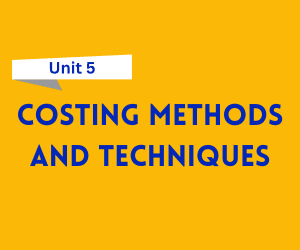Understanding different costing methods is essential for determining the cost of products or services in varied business environments. Depending on the nature of production or service, businesses use specific costing techniques to manage and analyze expenses effectively. This unit introduces the major methods of costing used in industries and service sectors.

Download UNIT 5 – Methods and Techniques of Costing Notes
Get simplified revision notes for this unit:
Download Unit 5 Notes PDF
Job Costing and Batch Costing
Job Costing:
Job costing is used when work is undertaken according to specific customer requirements. Each job or order is treated as a unique cost unit.
Suitable for: Furniture making, printing, interior designing, etc.
Costs are tracked separately for each job – materials, labour, and overheads are recorded job-wise.
Batch Costing:
Batch costing is applied when similar items are produced in groups or batches rather than individually.
Each batch is treated as a cost unit.
Cost per unit = Total batch cost ÷ Number of units in the batch.
Common in industries like pharmaceuticals, garments, and electronics.
Process Costing
Process costing is used in mass production industries where goods pass through multiple processes or stages.
Each process has its own cost center.
Costs are accumulated for each process and averaged over all units produced.
Normal and Abnormal Loss:
Normal Loss: Inevitable wastage during production (e.g., evaporation).
Abnormal Loss: Unexpected or avoidable losses (e.g., machine breakdown, human error).
Abnormal loss is recorded separately and investigated.
Industries using process costing include chemicals, oil refining, paper, and textiles.
Contract Costing
Contract costing is used for large construction or engineering projects that take longer durations to complete.
Each contract is treated as a separate cost unit.
Costs are recorded site-wise (materials, wages, plant usage).
Progress payments, retention money, and work certified are tracked.
Suitable for construction companies, shipbuilding, road projects, etc.
Operating Costing (Service Costing)
Operating costing is used to calculate the cost of services rather than physical goods.
Applied in organizations like transport services, hospitals, hotels, and canteens.
Cost units may be per km, per bed-day, per meal, etc.
Examples:
Transport: Cost per kilometer per passenger or ton.
Canteen: Cost per meal served.
It helps in controlling service costs and pricing efficiently.
Marginal Costing and Break-Even Analysis (Basic Introduction)
Marginal Costing:
Marginal costing focuses on variable costs. It helps in decision-making by analyzing how costs behave with changes in production volume.
Marginal cost = Additional cost of producing one more unit.
Fixed costs are treated as period costs (not allocated per unit).
Break-even Analysis:
Break-even analysis identifies the point where total revenue equals total costs — meaning no profit, no loss.
Break-even point (BEP) = Fixed Costs / Contribution per unit
It helps businesses determine the minimum output needed to avoid losses.
Marginal costing and break-even analysis are powerful tools for pricing, planning, and short-term decision-making.
